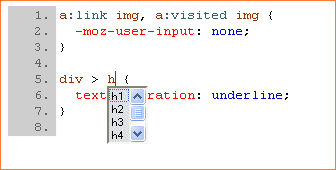A person named "LaC" left a rather strong comment on Ben Galbraith's blog. Since Ben's original article partly explains why canvas was chosen for Bespin, let me give you my personal view of the thing...
Diavolo, my source view editor, uses the editor in Gecko. So I had to deal with DOM nodes. Colorizing a word needs an element. Placing the caret in the middle of an element and typing a char needs expensive DOM operations to split the node in two if the grammar says the parsing was modified by the char. And if you're unlucky and it affects drastically the parsing of the rest of the document, well, you're doomed... All in all, dealing with a DOM here is so expensive that the performance is still poor on large files. The original parsing/rendering of a large file is too long. Ok, it's much better than it used to be, and my first attempt at a JS-based source editor in 2001 ended up nowhere because of Gecko itself.
So dealing with canvas - part of the HTML 5 standard - with good performance because there's no need to act on a DOM instead of contenteditable - part of the HTML 5 standard - with poor performance because you must deal with a DOM seems to me a natural choice, and a good choice. A markup-based editor for source is a workable solution if you don't want to implement complex features like rich syntax highlight, auto-completion, folding, exceptions allowing to put an instance conforming to one grammar inside another instance conforming to a different grammar (think for instance CSS embedded in HTML) and so on.
Last but not least, last time I checked Mozilla Labs' name contained the word "Labs". In general, labs are here to make experiments, things that don't seem ordinary or even reasonable, labs are here to pave the future, not do what all others are doing too.
 I improved a lot code completion in
I improved a lot code completion in  You can now test autocompletion in Diavolo, my source code editor, through my extension DiavoloTest for Firefox 3. Warning, it's not perfect yet, there are a few minor bugs, I know... Autocompletion is included for element types, properties and property values only. Not added yet for pseudos, functional notations and other CSS tokens.
You can now test autocompletion in Diavolo, my source code editor, through my extension DiavoloTest for Firefox 3. Warning, it's not perfect yet, there are a few minor bugs, I know... Autocompletion is included for element types, properties and property values only. Not added yet for pseudos, functional notations and other CSS tokens.



